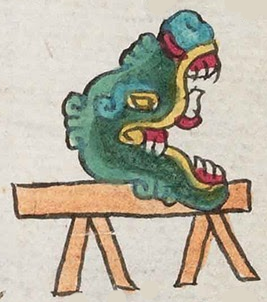Oztotlapechco (Mdz42r)
This compound glyph for the place name Oztotlapechco has two main visual elements. One is the the entrance to a cave (oztotl) that is shaped like a monster's head in profile, facing to the viewer's right. The head, largely green with a yellow eye and lips and red and white teeth, is resting on an orange-colored sawhorse-like platform (tlapechtli), probably made of wood. This is the other key element in the compound. The locative (-co), is not pictured.
Stephanie Wood
The curly features around the outer perimeter harken to the iconography of the stone (tetl], reminding us that there is actually a rocky outcropping around the mouth of the cave. The standard tepetl (hill, mountain) sign also has these rocky outcroppings, along with the two-tone bell shape that appears on its side here. The corner of the mouth and the corner of the eye also possibly convey something of the curliness of the tetl sign. Some interpret this animal as an earth monster. The opening of the cave is through the monster's mouth. According to the book In the Maw of the Earth Monster: Studies of Mesoamerican Ritual Cave Use, eds. James E. Brady and Keith Prufer (Austin: University of Texas Press, 2005), caves were sacred spaces, sites of rituals, and seen as providing access to the underworld, where there were divinities or deities. See also the analysis of caves by Holley Moyes, "Rites in the Underworld: Caves as Sacred Space in Mesoamerica," in Mexicolore, ed. Ian Mursell, where we learn that caves could overlap with the conceptualization of mouths and uteruses.
A temple at the pre-Hispanic archaeological site of Malinalco has an entrance that involves walking through a serpent or an earth monster's open mouth, and the interior is round and dark, being somewhat cave-like. The ruins at Chalcatzinco also have a stone carving of a simulated cave entrance that involves an opening that is "zoomorphically depicted as the mouth of the mountain lord/lightning deity’s animal familiar or co-essence, which in some cases is a serpent, lizard or crocodile and in others a jaguar," according to John E. Staller (quoted in Mexicolore).
Berdan and Anawalt relay that Peñafiel (1885, 159) was inclined to think of the wooden platform in this compound glyph for Oztotlapechco as an altar or maybe a burial ground. They also recall that Clark (1938, 2:46) suggested that the tlapechtli was meant to convey the verb tlapachoa, to fall in, and that the reading of the place name could therefore be "In the Place of the Fallen-In Cave." This is not, however, what they have concluded themselves. (See below.)
Stephanie Wood
oztotlapechco.po
Oztotlapechco, pueblo
Stephanie Wood
c. 1541, or by 1553 at the latest
Stephanie Wood
platforms, plataformas, andas, biers, caves, cuevas, monstruos, monsters, nombres de lugares

ozto(tl), cave, https://nahuatl.wired-humanities.org/content/oztotl
tlapech(tli), platform or bier, https://nahuatl.wired-humanities.org/content/tlapechtli
-co (locative), https://nahuatl.wired-humanities.org/content/co
"On the Platform of the Cave" (concurring with Berdan and Anawalt) [Frances Karttunen, unpublished manuscript, used here with her permission.]
"On the Platform of the Cave" (Berdan and Anawalt, 1992, vol. 1, 198)
"En la Plataforma de la Cueva"
Stephanie Wood
Codex Mendoza, folio 42 recto, https://digital.bodleian.ox.ac.uk/objects/2fea788e-2aa2-4f08-b6d9-648c00..., image 94 of 188.
The Bodleian Libraries, University of Oxford, hold the original manuscript, the MS. Arch. Selden. A. 1. This image is published here under the UK Creative Commons, “Attribution-NonCommercial-ShareAlike 3.0 License” (CC-BY-NC-SA 3.0).







